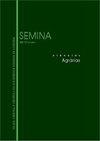巴西集约化养殖系统中母猪爪损的患病率和严重程度
IF 0.5
4区 农林科学
Q4 AGRICULTURE, MULTIDISCIPLINARY
引用次数: 0
摘要
在强化系统中饲养的猪极易受到爪子损伤的影响。中度至重度病变会引发炎症反应,引起疼痛并损害生殖和经济表现。母猪的足部损伤会由于繁殖能力下降和群体寿命缩短而造成相当大的损失。正确的诊断是纠正这一问题的重要步骤;然而,这些病变对猪群影响的严重性对大多数养殖场主来说仍然不清楚。健康监测已成为兽医的重要工具,因为它可以检测疾病的发生率和严重程度。在这项研究中,我们评估了在强化系统下饲养的母猪的爪子损伤,以确定巴西牛群中损伤的流行率和严重程度。对来自30个养殖场的2660头母猪的后肢爪进行了以下损伤检查:足跟过度生长和侵蚀(HOE)、足跟裂缝、白线损伤(WL)、趾壁水平和垂直裂缝、脚趾过度生长以及露爪过度生长或缺失。爪被分为正常(得分=0)、轻度(得分=1)、中度(得分=2)或重度(得分=3)。在99.1%的母猪中观察到至少一种类型的病变,而29.7%的母猪表现出严重病变。HOE是最常见的病变(89.9%的母猪),16.8%的母猪观察到严重的WL。病变的发生率和严重程度随着产次的增加而增加,但WL除外。在年轻雌性中,掌表面的病变比裂壁或过度生长的脚趾上的病变更常见,这在选择母猪进行繁殖时应该考虑。在巴西母猪中观察到爪部病变的高患病率。对这些病变的监测既快速又简单。定期监测提供了一段时间内牛群爪子健康状况的信息,使我们能够采取措施控制和治疗爪子损伤,避免问题恶化、提前扑杀动物以及相关的生产和经济损失。本文章由计算机程序翻译,如有差异,请以英文原文为准。
Prevalence and severity of claw lesions in sows in intensive systems in Brazil
Swines raised in intensive systems are highly susceptible to claw lesions. Moderate to severe lesions trigger an inflammatory response, causing pain and impairing reproductive and economic performance. Foot lesions in sows can cause considerable losses owing to reduced fertility and herd longevity. Proper diagnosis is an important step in correcting this problem; however, the seriousness of the impact of these lesions on swine herds remains unclear to most farm owners. Health monitoring has become an essential tool for veterinarians because it enables the detection of disease incidence and severity. In this study, we assessed claw lesions in sows reared under an intensive system to ascertain the prevalence and severity of lesions in Brazilian herds. The hind limb claws of 2,660 sows from 30 farms were examined for the following lesions: heel overgrowth and erosion (HOE), heel-sole cracks, white line lesions (WL), horizontal and vertical cracks in the toe wall, overgrown toes, and overgrown or missing dew claws. Claws were classified as normal (score = 0), mild (score = 1), moderate (score = 2), or severe (score = 3). At least one type of lesion was observed in 99.1% of the sows, whereas 29.7% displayed severe lesions. HOE was the most common lesion (89.9% of sows) and severe WL was observed in 16.8% of the sows. Lesions increased in prevalence and severity with parity, except for WL In young females, lesions on the volar surface were more common than those on cracked walls or overgrown toes, which should be considered when selecting gilts for breeding. A high prevalence of claw lesions was observed in Brazilian sows. Monitoring of these lesions is fast and simple. Regular monitoring provides information on claw health in a herd over time, allowing us to take measures to control and treat claw lesions, avoiding worsening of the problem, early culling of animals, and the associated productive and economic losses.
求助全文
通过发布文献求助,成功后即可免费获取论文全文。
去求助
来源期刊

Semina-ciencias Agrarias
农林科学-农业综合
CiteScore
1.10
自引率
0.00%
发文量
148
审稿时长
3-6 weeks
期刊介绍:
The Journal Semina Ciencias Agrarias (Semina: Cien. Agrar.) is a quarterly publication promoting Science and Technology and is associated with the State University of Londrina. It publishes original and review articles, as well as case reports and communications in the field of Agricultural Sciences, Animal Sciences, Food Sciences and Veterinary Medicine.
 求助内容:
求助内容: 应助结果提醒方式:
应助结果提醒方式:


